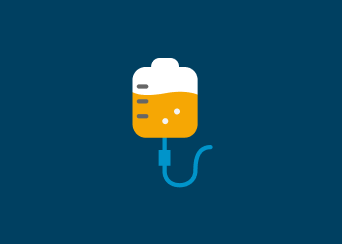Important Safety Information:
Vectibix® can cause skin side effects, which may be severe. In a clinical study, nearly all patients (90%) taking Vectibix® experienced skin rash or other skin reactions. Skin reactions included but were not limited to:
- Acne-like skin rash
-
Itching
-
Redness
-
Skin rash
-
Skin peeling
-
Nail infections at the side of the nail beds of the fingers or toes
-
Dry skin
-
Openings in the skin
Of these patients, 15% had severe skin reactions that involved, for some, pain, disfigurement,
ulceration, or loss of outer layers of skin when receiving Vectibix® alone. Some patients who developed
severe skin reactions also developed infections in the blood, skin, fat, or tissue that sometimes
resulted in death.
Your doctor may need to make changes to your dose to address your side effects or, in the event of
severe or life-threatening side effects, stop Vectibix® treatment. It is important that you tell your
doctor right away if you have any skin reactions or any signs of infection (such as chills, fever, or
increased redness or swelling of an existing skin reaction).
Patients who have metastatic colorectal cancer with RAS-mutant tumors should not receive Vectibix® with FOLFOX or alone.
Several clinical trials have been done evaluating treatments that block part of the pathway that
increases tumor cell growth (anti-epidermal growth factor receptor [EGFR]). Anti-EGFR treatments include
Vectibix® and Erbitux (cetuximab). In studies of these medicines, patients with RAS-mutant tumors
experienced serious side effects without any benefit from the treatment. In one study, patients with
RAS-mutant tumors who received Vectibix® + FOLFOX did not live as long as patients who received FOLFOX
alone.
Some patients who were taking Vectibix® developed low levels of certain electrolytes, including magnesium, calcium and potassium. Some patients also developed high levels of potassium. Your doctor may check the levels of these electrolytes in your blood while you are on treatment and for
up to 2 months after you finish treatment. Your doctor may add other oral or intravenous medications to
your Vectibix® treatment.
Vectibix® is given by infusion into a vein. Some patients may develop an infusion reaction, which can be
severe and in rare cases has resulted in death. In one clinical study, infusion reactions developed in
4% of patients, and 1% of patients experienced serious infusion reactions. Infusion reactions included:
-
Fever
-
Chills
-
Shortness of breath
-
Throat spasms
-
Low blood pressure
Depending on how severe the reaction is, your doctor may decide to slow the rate of the infusion, stop
the infusion, or stop your Vectibix® treatment completely.
Tell your doctor right away if you experience severe diarrhea or dehydration. Some patients treated with
Vectibix® and chemotherapy developed kidney failure and other complications because of severe diarrhea
and dehydration.
Lung disease, including fatal lung disease, occurred in 1% or less of patients who had taken Vectibix®.
Tell your doctor if you have problems breathing, wheezing, or a cough that doesn't go away or keeps
coming back. If you have had lung problems in the past, be sure to tell your doctor. Your doctor may
decide to stop Vectibix® treatment.
Being in the sun may make skin reactions worse. Wear sunscreen and protective clothing (such as a hat)
and avoid direct sunlight while you are on treatment with Vectibix®. Tell your doctor if you have new or
worsening skin reactions.
Inflammation of the eye and injury to the cornea have been reported. Tell your doctor if you have any
vision changes or eye problems. If you experience any of these side effects or they worsen, your doctor
should interrupt or discontinue Vectibix®.
In a study of patients treated for mCRC, the addition of Vectibix® to the combination of Avastin
(bevacizumab) and chemotherapy caused patients to experience severe side effects and to not live as long
as patients receiving only Avastin and chemotherapy. Do not take Avastin with Vectibix®.
-
Some moderate to severe side effects happened at a higher rate for Vectibix® patients, including
acne-like rash, diarrhea, dehydration, painful ulcers and mouth sores, and abnormally low levels of
potassium and magnesium in the blood.
-
Serious or potentially fatal blood clots that traveled to the lungs occurred more in
Vectibix®-treated patients, and less than 1% of Vectibix®-treated patients died.
-
Because of the side effects experienced, patients receiving Vectibix®, Avastin, and chemotherapy
received less chemotherapy for the first 24 weeks of the study compared with those receiving
Avastin and chemotherapy.
Vectibix® can cause harm to an unborn child. Use effective birth control to avoid pregnancy while taking
Vectibix® and for at least 2 months after the last dose.
In patients who received Vectibix® alone, the most commonly reported side effects (experienced by 20% or
more of patients) were different types of skin rash, infections at the side of the nail beds of the
fingers or toes, fatigue (extreme tiredness), nausea, and diarrhea.
In patients who received Vectibix® + FOLFOX, the most commonly reported side effects (experienced by 20%
or more of patients) were diarrhea, sore mouth, inflammation of mucous membranes, weakness, infection of
the nail beds, loss of appetite, low magnesium, low potassium, rash, acne-like skin rash, itching, and
dry skin. Serious side effects were diarrhea and dehydration.
These are not all the possible side effects of Vectibix®. Call your healthcare provider for medical advice about side effects. You may report side effects to FDA at 1-800-FDA-1088.
Please read the full Prescribing Information and discuss it with your doctor.







